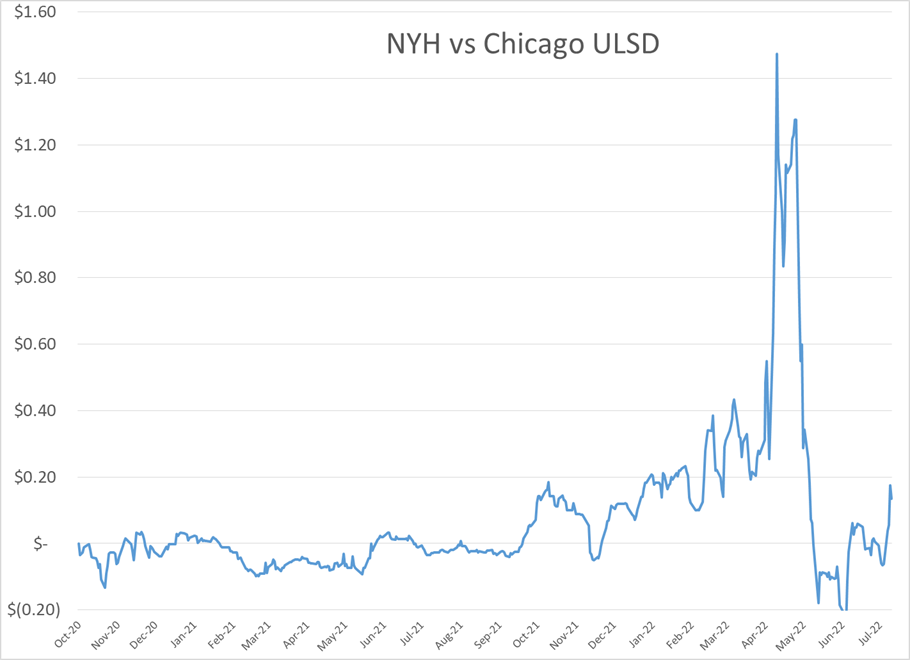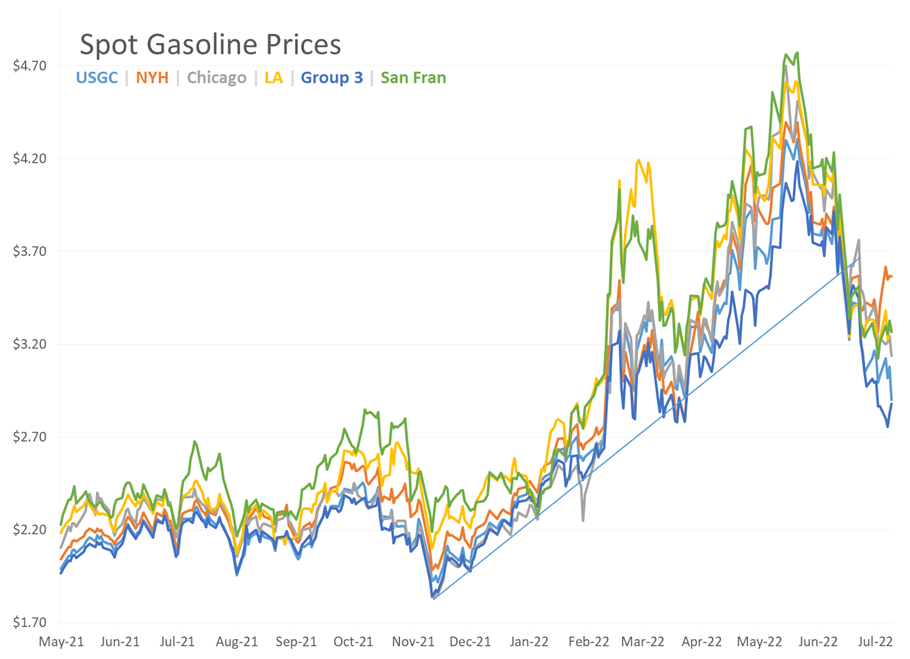Diesel Prices Ran Into A Wall At The $3.80 Mark Thursday And Quickly Dropped By 16 Cents In An Emphatic Demonstration Of Technical Resistance

Diesel prices ran into a wall at the $3.80 mark Thursday, and quickly dropped by 16 cents in an emphatic demonstration of technical resistance, leaving the energy complex in its sideways trading range. RBOB initially followed that pattern, dropping more than a dime after hitting the top end of its trading range, but then the expiring August contract decoupled from the rest of the energy train and continued moving higher, and setting a new record premium vs the 2nd month contract.
Today is the last trading day for the August RBOB and ULSD contracts, and the lack of volume on expiration day is already causing fireworks that look impressive on the charts, but won’t matter to almost everyone who buys fuel, since the September contracts will determine tonight’s pricing moves. For example: As of 8am central, August RBOB prices are up 15 cents/gallon, but most cash markets are following the September RBOB contract which is “only” up 6.
The extreme backwardation in gasoline prices is not just showing up in the futures market. Prompt RBOB values in the NYH are trading some 40 cents above values for barrels delivered 2 weeks from now, and 68 cents higher than RBOB on the Gulf Coast as a short squeeze for summer gasoline grips parts of the East Coast, even while other parts of the country are having trouble finding buyers. This seems to be a less extreme example of what we saw in April and May when New York Harbor diesel prices spiked to premiums of $1.20/gallon or more compared to its neighboring cash markets. The forward pricing curve suggest that this spread will collapse in August, just as we saw diesel premiums collapse in May (see charts below).
One extra challenge for the East Coast, there were several forecasts when the war in Ukraine started that European refiners would run full out to make as much diesel as possible, and end up with excess gasoline to be sent to the US, but some of those facilities are now running well below capacity as soaring natural gas costs (and/or limited supply) make operations uneconomical for some and unfeasible for others. For those that remember last year’s freeze induced natural gas price spike and shortages that led to every refinery in Texas to cut operating rates, this scenario playing out in Europe is easy to understand, as is the potential fallout from the lack of output.
Right on cue, PBF announced it is bringing its idled crude unit in Paulsboro NJ back into operation after shutting it down to try and avoid bankruptcy during the depths of the COVID demand slump.
In other earnings news, Pemex announced that they made $862 million in EBITDA in the first 6 months of operations at the Deer Park refinery, which is $150 million more than they paid for their interest in the facility. Still no word from Shell if they’d like a do-over on any of the refineries they dumped in the past two years.
Valero joined most other refiners, smashing its records for profitability during the quarter, increasing run rates to 94% of capacity, up from 74% 2 years ago. The company also had record renewable diesel production, and expects its next RD expansion project to be completed by the end of the year. In a sign of the market’s skepticism over the forward outlook of fuel demand, the company’s stock dropped after the announcement even though earnings surpassed most published expectations.
The senate spending deal that surprised many this week has good news for biofuel producers in that the $1/gallon blenders tax credit is expected to be extended for another 2 years. One potentially painful mistake however is that the bill also includes a $1.25/gallon tax credit for sustainable aviation fuels, which means producers will get an extra 25 cents/gallon to make SAF instead of BIO or RD, which could heat up the feedstock wars once again and send fuel that had been used over the road for the past decade into the skies. The bill includes numerous other potential credits and incentives for both renewable and traditional fuel production, and capturing the carbon created by those projects.
Click here to download a PDF of today's TACenergy Market Talk.
Latest Posts
Energy Markets Rally Again Thursday After A Choppy Wednesday Session
Week 16 - US DOE Inventory Recap
Energy Markets Trading Quietly In The Red As Ethanol Prices Rally To Five-Month High
The Struggle For Renewable Producers Continues As A Rapid Influx Of Supply And Crashing Credit Prices Make Biodiesel
Social Media
News & Views
View All
Energy Markets Rally Again Thursday After A Choppy Wednesday Session
Energy markets are trying to rally again Thursday after a choppy Wednesday session. RBOB gasoline futures are leading the push higher, on pace for a 3rd consecutive day of gains after finding a temporary floor Tuesday and have added 12 cents from those lows.
Equity markets are pointing sharply lower after a weak Q1 GDP estimate which seems to have contributed to a pullback in product prices over the past few minutes, but don’t be surprised if the “bad news is good news” low interest rate junkies start jumping in later on.
The DOE’s weekly report showed sluggish demand for gasoline and diesel, but inventory levels in most markets continue to follow their typical seasonal trends. Refinery runs held fairly steady last week with crude inputs down slightly but total gross throughputs up slightly as most facilities are now back online from a busy spring maintenance season and geared up for peak demand this summer.
Propane and propylene exports spiked to a record high north of 2.3 million barrels/day last week, which demonstrates both the US’s growing influence on global product markets, and the steady shift towards “other” products besides traditional gasoline and diesel in the level of importance for refiners.
The EIA acknowledged this morning that its weak diesel consumption estimates reflected the switch to Renewable Diesel on the West Coast, although they did not provide any timeline for when that data will be included in the weekly survey. The agency acknowledged that more than 4% of the total US consumption is now a combination of RD and Biodiesel, and that number is expected to continue to grow this year. This morning’s note also suggested that weak manufacturing activity was to blame for the sluggish diesel demand across the US, while other reports suggest the freight recession continued through Q1 of this year, which is also contributing to the big shift from tight diesel markets to oversupplied in several regions.
Valero kicked off the Q1 earnings releases for refiners with solid net income of $1.2 billion that’s a far cry from the spectacular earnings north of $3 billion in the first quarter of 2023. The refining sector made $1.7 billion, down from $4.1 billion last year. That is a pattern that should be expected from other refiners as well as the industry returns to a more normal market after 2 unbelievable years. You wouldn’t guess it by looking at stock prices for refiners though, as they continue to trade near record highs despite the more modest earnings.
Another pattern we’re likely to see continue with other refiners is that Renewable earnings were down, despite a big increase in production as lower subsidies like RINs and LCFS credit values sting producers that rely on those to compete with traditional products. Valero’s SAF conversion project at its Diamond Green joint venture is progressing ahead of schedule and will give the company optionality to flip between RD and SAF depending on how the economics of those two products shakes out this year. Valero also shows part of why refiners continue to disappear in California, with operating expenses for its West Coast segment nearly 2X that of the other regions it operates in.

Week 16 - US DOE Inventory Recap

Energy Markets Trading Quietly In The Red As Ethanol Prices Rally To Five-Month High
Energy markets are trading quietly in the red to start Wednesday’s session after a healthy bounce Tuesday afternoon suggested the Israel-Iran-linked liquidation had finally run its course.
There are reports of more Ukrainian strikes on Russian energy assets overnight, but the sources are sketchy so far, and the market doesn’t seem to be reacting as if this is legitimate news.
Ethanol prices have rallied to a 5-month high this week as corn and other grain prices have rallied after the latest crop progress update highlighted risks to farmers this year, lower grain export expectations from Ukraine, and the approval of E15 blends this summer despite the fact it pollutes more. The rally in grain and renewables prices has also helped RIN values find a bid after it looked like they were about to test their 4-year lows last week.
The API reported small changes in refined product inventories last week, with gasoline stocks down about 600,000, while distillates were up 724,000. Crude oil inventories increased by 3.2 million barrels according to the industry-group estimates. The DOE’s weekly report is due out at its normal time this morning.
Total reported another upset at its Port Arthur refinery that’s been a frequent flier on the TCEQ alerts since the January deep freeze knocked it offline and damaged multiple operating units. This latest upset seems minor as the un-named unit impacted was returned to normal operations in under an hour. Gulf Coast basis markets have shrugged off most reports of refinery upsets this year as the region remains well supplied, and it’s unlikely we’ll see any impact from this news.
California conversely reacted in a big way to reports of an upset at Chevron’s El Segundo refinery outside of LA, with CARBOB basis values jumping by more than a dime. Energy News Today continued to show its value by reporting the upset before the flaring notice was even reported to area regulators, proving once again it’s ahead of the curve on refinery-related events. Another industry news outlet meanwhile struggled just to remember where the country’s largest diesel seller is located.
Click here to download a PDF of today's TACenergy Market Talk




